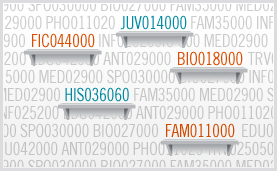
BISAC codes are assigned to every title in the marketplace, and publishing teams work hard to assign the right codes—so, what exactly are BISACs and why do they matter? We demystify the process behind BISACs and take a look at some surprising marketplace trends they reveal.
What Are BISAC Codes?
BISAC stands for “Book Industry Standards and Communications” and is a subcommittee of the Book Industry Study Group (BISG). This committee is charged with setting an industry-wide book classification system to which all publishers adhere. While every book published must have at least one code, in theory a book can have unlimited codes assigned to it. Each level can range from very general (“Fiction—General”) to very specific (“Fiction—Mystery & Detective—Women Sleuths”).
Why Do They Matter?
With a selection of over 3,000 codes to choose from, assigning the right BISAC is imperative on many levels. For one, it’s the best way we as publishers have to tell our accounts (in an automated way) what our books are about. Armed with that information, bookstores rely heavily on BISAC codes to decide store placement and merchandising for titles. On the digital side, BISAC codes affect a book’s discoverability in search engines and also on the “shelves” of online retailers. With an increasing number of shoppers shifting online to find their next purchase, it’s crucial that customers can find relevant titles with a quick search. Random House uses up to three layers of BISAC codes for each title in its data feeds to increase visibility across multiple shelves. (If you have any questions about the BISAC code for your title, please reach out to your editor.)
One great example of a BISAC affecting discoverability is Justin Cronin’s 2011 bestseller The Passage. Before writing The Passage, Cronin had written novels classified as literary fiction. While his Random House publishing team knew that fans of literary fiction would love The Passage, they also recognized other opportunities for crossover with thriller readers, as well as with fantasy/science fiction fans. Attaching “Literary Fiction,” “Fantasy,” and “Thriller” as three appropriate BISACs to the book makes it more likely to be discovered, as The Passage will now surface in search results in multiple categories.
Increased discoverability online helps online and offline sales of print and digital editions. If a book is about single parenthood, for example, then using the code “Family & Relationships—Parenting—Single Parent” helps the consumer find that book online—because the BISAC code is read by search engines and helps the book show up in a search on “single parenting.” A publisher might lose that sale with the less specific code “Family and Relationships—Parenting.” The consumer can then purchase the book online or at a local store.
Many times, we’ve seen the direct benefit that a specific BISAC code can have for a title. For example, for one already strong-selling title published by Random House, the initial BISAC was “Fiction—General.” After we changed the code to “Fiction—Suspense,” the title showed up on that additional category bestseller list, and sales increased by 55 percent!
Choosing the right BISAC can also lead to enhanced merchandising opportunities. As Matt Schwartz, V.P., director of digital marketing strategy and product development, Random House Publishing Group, notes: “BISAC category codes can serve multiple purposes, including impacting search results at retailers and being included in certain merchandising opportunities that pull in titles automatically based on category. In the past, books were merchandised in just one part of a bookstore—i.e., General Fiction, Cooking, Mystery, etc. With BISACs, we have the ability to reach multiple audiences for a book, in several in-store locations, for potential multiple demographics.”
What Can They Tell Us?
The appearance—or disappearance—of BISAC codes from the BISG’s catalogue often indicates genre trends seen across the industry. Codes added to the catalogue can signify a new trend gaining traction; similarly, retired codes reflect a genre that no longer needs its own categorization. For example, in 2012 the BISG added eight new codes to the Fiction list, including “Amish & Mennonite,” “Dystopian,” “Science Fiction/Steampunk,” and “Romance/Erotica.” The BISG is constantly updating its catalogue to keep up with demands in the marketplace.
The publishing teams at Random House work hard to make the best BISAC choices for each title we publish to increase visibility in bookstores and online. As Schwartz says, “In a world where discoverability of titles online can be challenging, choosing categories carefully can be an incredibly powerful tool of discoverability that the publisher has direct control over.”
Andrea Bachofen is part of the Digital Publishing Development Group.

